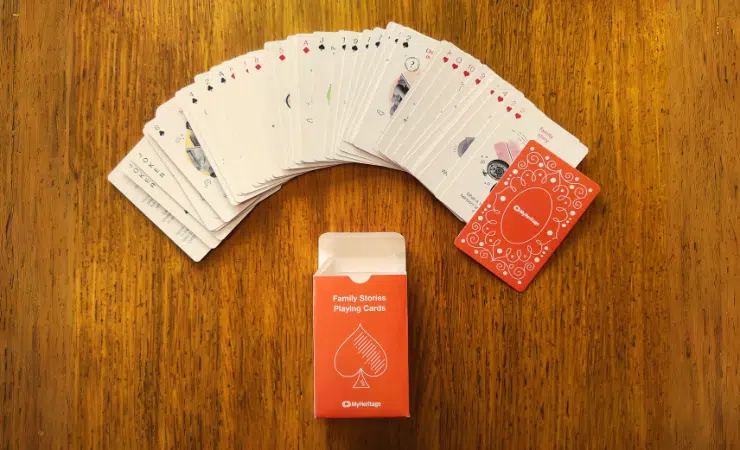
Games are an excellent way to get your family talking about family history. They can gently encourage older family members to tell stories and share memories, while inspiring youngsters to ask questions and take an interest in the details being shared.
That’s why we developed our Family Story Playing Cards to hand out as a free gift at the RootsTech conference last year: a unique deck of cards that have numbers and suits like regular playing cards, but also contain prompt questions and challenges about family history. They were gone in a flash, and we brought them back this year by popular demand!

Not a RootsTecher, or didn’t get the chance to grab one? No worries: you can download our free printable PDF and print your own deck at home! Print them on thick paper and cut them out as another fun family activity, or use regular paper and paste them onto cardboard.
Once you have your Family Story Playing Cards on hand, here are 5 ideas for classic card games with a family history twist that you can play with them.
Go Fish for Family Stories
Number of players: 2–6
Objective: To collect the highest number of sets
Setup:
- Deal 7 cards to each player if there are 3 or fewer players, or 5 cards to each if there are 4 or more.
- Place the remaining cards at the center of the table as a draw pile.
- Players look at their own cards but hide them from the other players.
Play:
- When it’s your turn, ask another player if they have any cards of a certain rank (e.g. 4s or jacks) that will help you complete a set of 4.
- The family history twist: If the player you asked has any of the cards, they will read you the question or challenge on the card and you must answer successfully to win it. If they have more than one card of the same rank, they must give them to you, but only if you answer all the questions or challenges successfully.
- If the player you asked doesn’t have any of the cards you asked for, or if you didn’t manage to answer the question on the card, they say “Go fish” and you must draw a card from the pile.
- If you “fished” a card from the pile that matches what you asked for, you say “Fished my wish!” and get another turn.
- If you collect 4 cards of the same rank, that makes a set. Place it face up on the table and get another turn.
- Continue playing until all the cards in the deck have been made into sets. The person with the highest number of sets wins!
Family Story War
Number of players: 2–3
Objective: To collect all the cards in the deck
Setup:
- Divide the deck equally between the players. If playing with 3 players, remove the extra card at random and set it aside.
- Players should not look at their cards.
Play:
-
- All players simultaneously turn over the top card on their deck and place it face-up in the center.
- The player with the highest number (with 2 being the lowest and ace being the highest) wins the round.
- If the cards are of equal rank (or the two highest cards in a 3-person game), a “war” is declared: each player places 3 cards face down in the center, then one card face-up. The highest card wins all the cards on the table. If the new cards are also equal, the process is repeated until there is a winner.
- The family history twist: Before the winner can collect, they must answer the question or challenge on the lowest card that was played. If they answer successfully, they collect the cards on the table and place them at the bottom of their pile. If they don’t, a war is declared!
- The person who ends up with the entire deck wins!

Family Story Rummy
Number of players: 2–6
Objective: To get rid of all your cards by placing them on the table in sets or runs.
Setup:
- Deal cards to each player:
- 2 players: 10 cards per player
- 3–4 players: 7 cards per player
- 5–6 players: 6 cards per player
- Place the remaining cards face down on the table to form a stockpile.
- Take the top card from the stockpile and turn it face up to start the discard pile.
Play:
-
- Players take turns in clockwise order.
- Each turn consists of the following actions:
- Drawing a card, either from the stockpile or from the discard pile
- Creating any possible sets or runs using the cards in hand (explanation to follow)
- Discarding one card into the discard pile
- Sets and runs:
-
-
- A set is 3 or more cards of the same rank, for example 3 kings or 3 7s.
- A run is 3 or more cards of the same suit in sequential order, for example the 4, 5, and 6 of hearts.
- A player can also use the sets and runs already on the table to create a new set or run, as long as all the cards still belong to a set or run. For example, if there’s a run of the 4, 5, and 6 of hearts on the table, the 7 of hearts can be added. If another player has two 7s, they can take the 7 of hearts from that 4-card run to form a new set of 7s, because the run will still contain 3 cards.
-
- The family history twist: Whenever a player creates a set or run, they must choose a question or prompt from the cards in play and answer it before they can complete the move.
- If the stockpile is depleted, shuffle the discard pile, turn it over, and turn it into the new stockpile.
- The first player to get rid of all their cards wins!

Family Story Slap
Number of players: 2+
Objective: To collect all the cards in the deck.
Setup:
- Divide all the cards evenly between the players (players must not look at their cards).
- Set any extra cards face up at the center of the table.
Play:
-
- Each player in turn takes the card at the top of their deck and flips it face up to create a pile in the middle of the table. Play continues until someone collects the pile by playing a royal or slapping a double (explanations below).
- The family history twist: The player who wins a round must answer the question or challenge on the card at the top of the pile before collecting. If they are unable to answer successfully, the round starts over with the next player placing a card on top of the existing pile.
- If a royal card is played, the following player must place down 1–4 cards according to the rank of the royal:
- 4 cards for an ace
- 3 cards for a king
- 2 cards for a queen
- 1 card for a jack
- If another royal emerges within these allotted cards, the challenge moves to the next player, who must place down the allotted number of cards according to the rank of the new royal.
- The person who placed the last royal (and answers the question on the top card successfully) collects the cards.
- At any point in the game, if two cards of the same rank (for example, two 7s or two queens) are placed on top of each other (a double), any player can slap a hand down on top of the pile. The person who slapped the pile first (and successfully answers the question on the top card) collects the pile.
- The player who collects all the cards in the deck wins!
Enjoy — and don’t forget to add any new stories or details that come up to your family tree on MyHeritage!
Download the free printable MyHeritage Family Story Playing Cards




